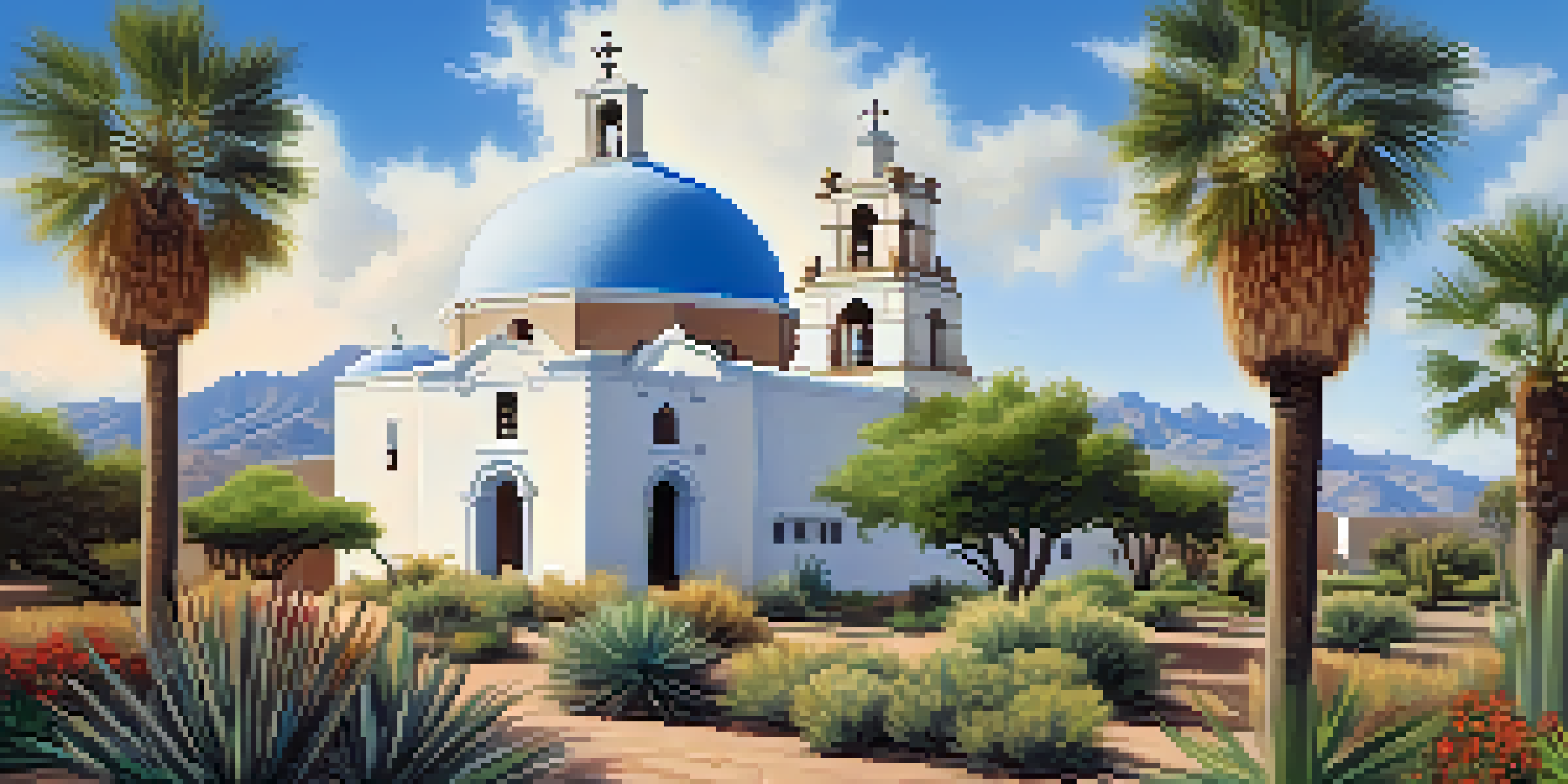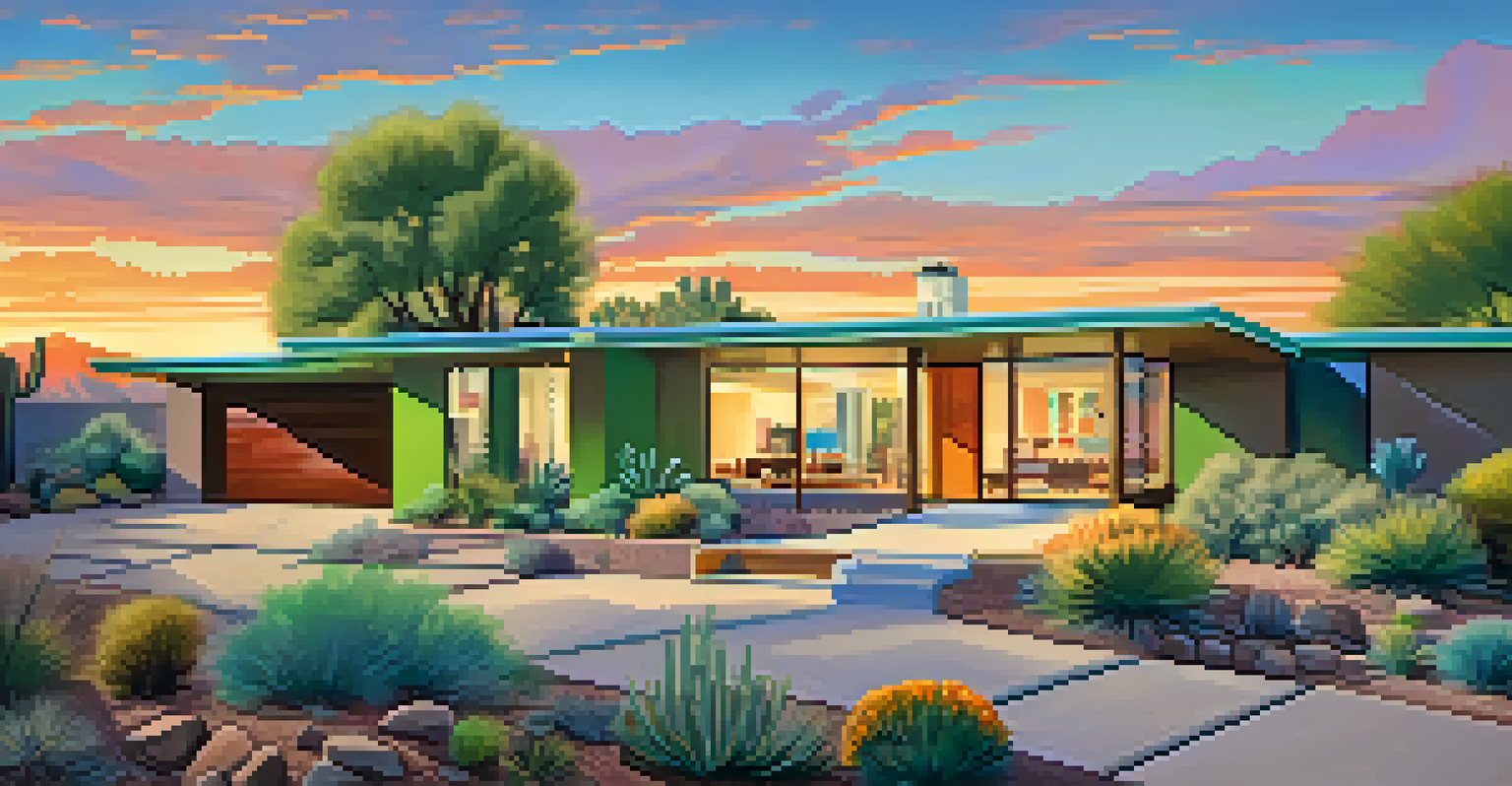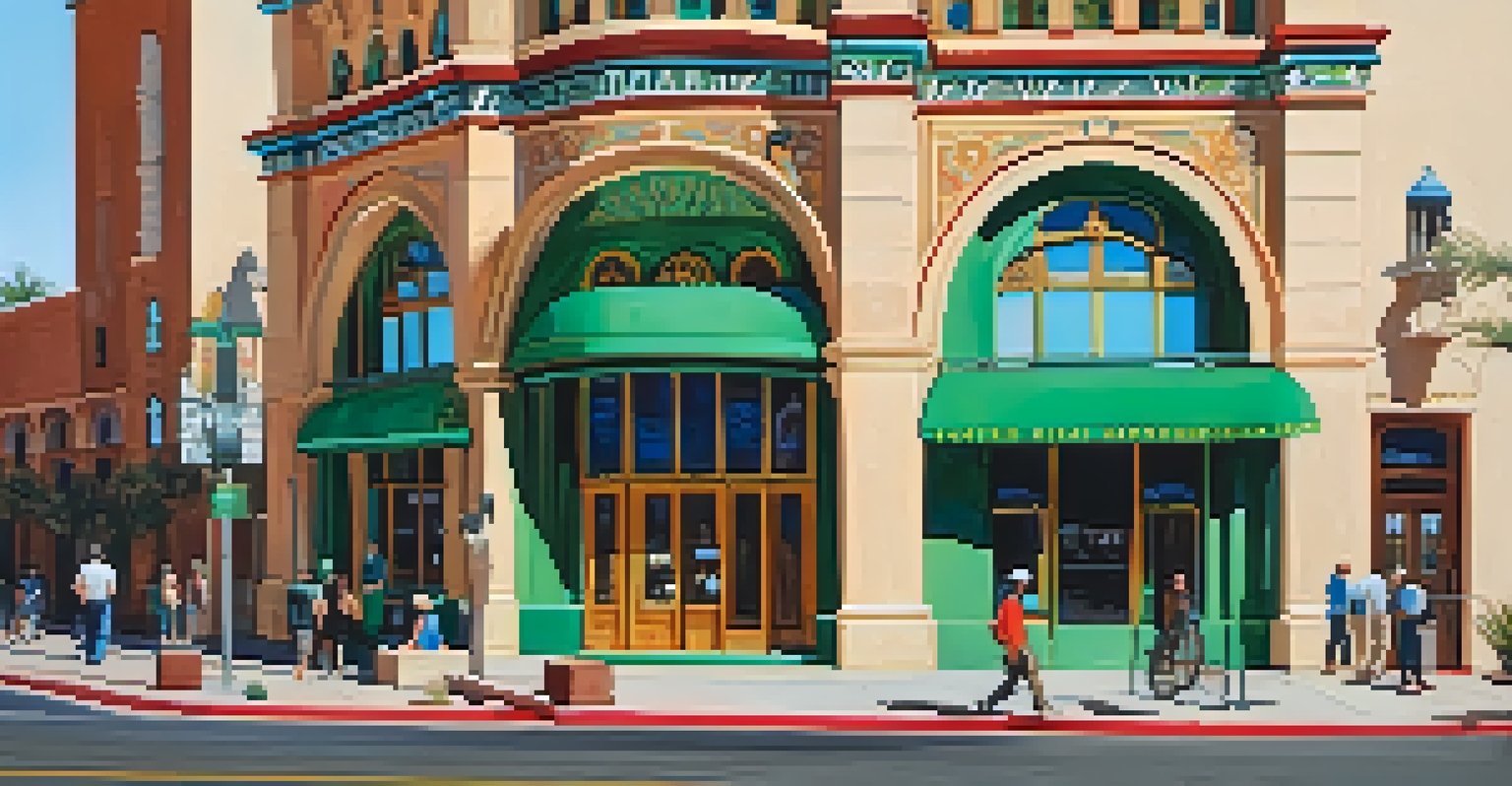A Deep Dive into Tucson's Architectural Heritage Sites

An Overview of Tucson's Architectural Landscape
Tucson's architectural heritage is a vibrant tapestry woven with diverse styles, reflecting its rich history and cultural influences. From Spanish colonial structures to modernist designs, the city tells a unique story through its buildings. This mix not only showcases architectural innovation but also honors the traditions of the indigenous peoples and settlers who shaped the region.
Architecture is the most public of the arts, a form of communication that, when done well, can elevate the entire community.
Walking through Tucson is akin to flipping through a history book, with each site revealing layers of time and culture. For instance, the iconic Mission San Xavier del Bac stands as a testament to Spanish colonial architecture, captivating visitors with its intricate details and serene surroundings. At the same time, mid-century modern homes in neighborhoods like Sam Hughes highlight the city's evolution into the contemporary era.
As we delve into Tucson's architectural treasures, we'll uncover how these sites reflect broader social and historical contexts. Each landmark not only serves its purpose but also invites us to appreciate the artistry and craftsmanship behind its creation. Join us as we explore the stories behind some of Tucson's most significant architectural heritage sites.
The Influence of Spanish Colonial Architecture
Spanish colonial architecture in Tucson is marked by its use of adobe, tile roofs, and arched doorways, creating an inviting atmosphere that embodies the region's heritage. One of the standout examples is the San Xavier del Bac Mission, often referred to as the 'White Dove of the Desert.' This stunning structure, founded in the late 1700s, showcases the Baroque style and is a significant pilgrimage site for locals and visitors alike.

The mission's intricate façade is adorned with symbolic motifs that reflect both Spanish and Native American influences, illustrating a harmonious blend of cultures. As you approach the mission, the serene landscape enhances its beauty, making it a favorite spot for photography and contemplation. The architecture tells a story of faith, resilience, and community, inviting you to pause and reflect on its historical significance.
Tucson's Rich Architectural Heritage
Tucson's diverse architectural styles reflect its vibrant history, blending influences from Spanish colonial, Native American, and mid-century modern design.
Beyond San Xavier, the Spanish colonial influence can be seen in various structures throughout Tucson, from the historic El Presidio neighborhood to the elegant adobe homes that line the streets. These buildings not only serve as a reminder of the past but also continue to inspire contemporary architects who seek to incorporate traditional elements into modern designs.
Exploring Native American Architectural Contributions
Tucson's architectural heritage is incomplete without recognizing the profound impact of Native American culture. The Tohono O'odham and Pascua Yaqui tribes, among others, have shaped the region's landscape for centuries, leaving behind structures that reflect their unique traditions. For instance, the traditional adobe homes, or 'bahay,' showcase sustainable building practices that harmonize with the desert environment.
Preservation is not just about saving old buildings; it's about saving the stories and memories that define a community.
These homes are designed to keep interiors cool in the scorching heat while providing warmth during the chilly nights. The use of local materials and techniques not only reflects a deep understanding of the landscape but also a respect for nature that is vital in Native American philosophy. Visiting these sites offers a glimpse into a way of life that emphasizes community and connectivity with the land.
In modern times, Native American artists and architects continue to influence Tucson's architectural scene, blending ancestral designs with contemporary aesthetics. This ongoing dialogue between past and present enriches the city's cultural fabric, reminding us of the enduring legacy of its original inhabitants.
The Charm of Historic Downtown Tucson
As you stroll through downtown Tucson, the blend of historic and modern architecture invites exploration and discovery. The area is home to a variety of buildings, each with its own story, from the stately Pima County Courthouse to the colorful Hotel Congress. These structures not only serve functional purposes but also embody the spirit of the city, reflecting its growth and evolution over the years.
The Pima County Courthouse, with its striking green dome and intricate tile work, is a prime example of Spanish Revival architecture that dominates the skyline. This architectural gem is not just beautiful; it also houses important civic functions and stands as a symbol of local governance. Meanwhile, the Hotel Congress, a historic landmark, has welcomed countless travelers and artists, preserving its vintage charm while adapting to modern hospitality needs.
Importance of Preservation Efforts
Local organizations work diligently to preserve Tucson's architectural landmarks, ensuring future generations can appreciate the city’s unique historical narrative.
Downtown Tucson also hosts numerous events that celebrate its architectural heritage, from guided walking tours to art festivals. These gatherings foster a sense of community and encourage appreciation for the city's rich history, making downtown a vibrant hub for both locals and visitors alike.
Mid-Century Modernism in Tucson
The mid-20th century marked a significant shift in Tucson's architectural style, embracing modernism with open arms. This era introduced sleek lines, open spaces, and innovative materials that transformed the city’s residential and commercial landscapes. One notable example is the Tucson Botanical Gardens, which features mid-century structures that blend seamlessly with the lush surroundings.
As you explore neighborhoods like the Sam Hughes area, you'll find charming mid-century homes that boast large windows and integration with nature. These designs reflect a departure from traditional styles, focusing on functionality and the relationship between indoor and outdoor spaces. This architectural movement not only provides a unique aesthetic but also promotes a lifestyle that values simplicity and connection to the environment.
Today, mid-century modern homes are highly sought after, with many being carefully restored to preserve their original charm. This resurgence highlights a growing appreciation for this era’s design philosophy, as homeowners and architects alike recognize the timeless appeal of mid-century modernism in Tucson's architectural narrative.
Preservation Efforts: Keeping History Alive
As Tucson continues to grow and evolve, the importance of preserving its architectural heritage cannot be overstated. Local organizations and advocacy groups work tirelessly to protect and restore significant sites, ensuring that future generations can appreciate these treasures. Efforts include securing funding for restoration projects, promoting awareness, and fostering community involvement in preservation initiatives.
One successful example is the Tucson Historic Preservation Foundation, which has spearheaded numerous projects aimed at maintaining the city's architectural integrity. Through their initiatives, they not only restore buildings but also educate the public about the historical context and significance of these sites. Their work highlights the need for a collective effort to honor Tucson’s past while embracing its future.
Cultural Events Foster Community
Events celebrating Tucson's architectural heritage enhance community engagement and appreciation for the city's unique architectural gems.
Preservation is not just about maintaining aesthetics; it's about safeguarding stories and memories that define a community. By investing in the preservation of architectural heritage, Tucson fosters a sense of identity and belonging, creating a city that respects its roots while looking forward to what lies ahead.
Cultural Events Celebrating Architectural Heritage
Tucson's architectural heritage comes alive through various cultural events that celebrate its unique history and design. Events like the Tucson Modernism Week attract architecture enthusiasts, offering tours, lectures, and exhibitions that highlight the city’s mid-century modern gems. These gatherings provide a platform for architects, historians, and the community to engage in meaningful discussions about the significance of architectural preservation.
Another notable event is the annual El Tour de Tucson, which not only promotes fitness but also showcases the city's scenic routes, including its stunning architectural landmarks. Participants pedal through historic neighborhoods, giving them a chance to appreciate the beauty of Tucson’s diverse architectural styles while enjoying the great outdoors. This blend of culture and community fosters a deeper connection to the city’s heritage.

These events are vital in creating a shared appreciation for Tucson’s architectural gems, encouraging residents and visitors alike to explore and engage with the city’s history. By participating in these celebrations, people contribute to a growing movement that values and protects the unique architectural legacy of Tucson.
The Future of Tucson's Architectural Heritage
Looking ahead, the future of Tucson's architectural heritage is both exciting and challenging. As the city continues to grow and adapt to modern needs, balancing development with preservation will be crucial. Innovative approaches that incorporate sustainable practices and respect for historical context can lead to a harmonious blend of old and new, enriching Tucson’s architectural tapestry.
Architects and urban planners are increasingly focusing on designs that honor the past while addressing contemporary issues. This includes repurposing historic buildings for modern use, ensuring that they remain relevant and functional in today’s society. Such adaptability not only preserves the physical structure but also keeps the stories and memories associated with these sites alive.
Community involvement will play a key role in shaping Tucson's architectural future. As residents advocate for thoughtful development and preservation efforts, the city can maintain its unique character, ensuring that its architectural heritage continues to thrive for generations to come. Through collaboration and a shared vision, Tucson can celebrate its past while embracing the possibilities of the future.